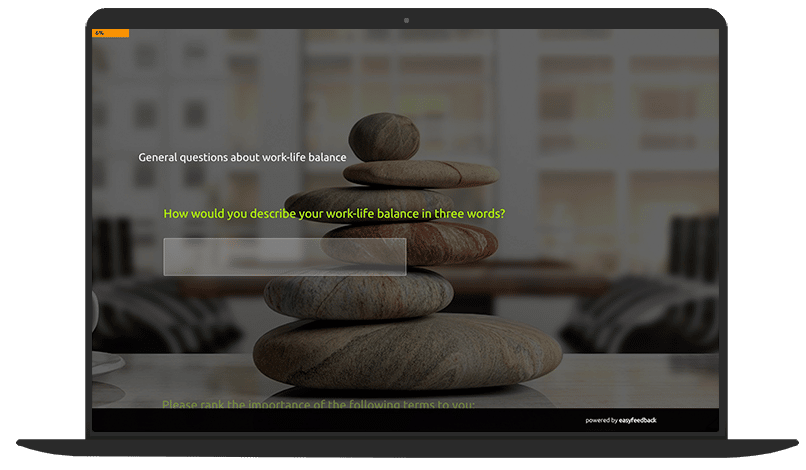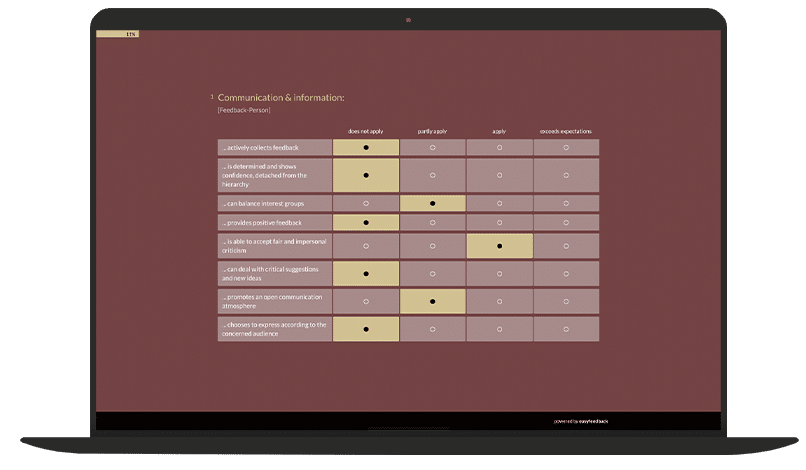What is Employee Experience Management?
Employee Experience Management (EEM) refers to the holistic approach taken by companies to shape, improve and optimize the experiences that their employees have throughout their employment.
It is about taking into account and shaping the interactions that employees have with their employer, as well as their impressions, emotions and perceptions throughout their entire journey with the company.

In other words, creating a working environment that inspires, motivates and empowers employees to reach their full potential.
This includes aspects such as corporate culture, leadership, working environment, well-being, development opportunities, recognition and reward systems, communication and the technological tools and processes available to employees.
Why is Employee Experience important?
Employee experience is crucial because it has a direct impact on various aspects of the organization.
First of all, a positive employee experience helps employees feel connected to their company and that their time spent working there is meaningful and rewarding.
This in turn promotes employee engagement and increases the likelihood that they will actively contribute to the success of the company.
Employee experience also has an impact on employee retention.
If employees experience a pleasant and supportive working environment, they are more likely to remain loyal to the company.

This reduces the fluctuation rate, which both lowers the costs of training new employees and promotes continuity and stability within the company.
A positive employee experience also has an impact on the company’s attractiveness as an employer.
Organizations that are known for a good employee experience attract talented applicants and have a higher chance of attracting highly qualified employees.
This is particularly important in a highly competitive environment where skilled labor is a scarce resource.
In addition, the employee experience influences customer loyalty. Satisfied and engaged employees are more likely to go the extra mile to meet customers’ needs and provide excellent service.
This leads to a positive customer experience, which in turn strengthens customer loyalty and supports the growth and success of the company in the long term.
In summary, a positive employee experience is crucial as it not only promotes employee wellbeing and satisfaction, but also has a direct impact on performance, employee retention, employer attractiveness and customer loyalty.
How does sustainable employee experience management work?
Sustainable employee experience management works by focusing on long-term and holistic measures that promote employee wellbeing, satisfaction and engagement.
Here are some steps to help you achieve sustainable employee experience management:
1. Culture and values
Companies should promote a corporate culture based on trust, respect, openness and cooperation.
Corporate values should not just be written on paper, but should be tangible in all aspects of company life.
2. Employee participation
Employees should be actively involved in decision-making processes and have the opportunity to give feedback and make suggestions.
This strengthens the sense of belonging and commitment.
3. Working environment
The physical and virtual working environment should be designed in such a way that it promotes the productivity, creativity and well-being of employees.
This includes ergonomic workstations, flexible working hours and the use of modern technologies.

4. Development opportunities
Companies should offer their employees opportunities for further development and professional training.
This can be done through training, mentoring programs, career development discussions and other development initiatives.
5. Recognition and reward
Employee performance should be regularly recognized and rewarded, be it through financial incentives, praise, promotions or other forms of recognition.
This strengthens employees’ self-esteem and motivates them to give their best.
6. Work-life balance
Companies should implement programs and measures to promote a healthy work-life balance for their employees, e.g. flexible working time models, home office options and vacation arrangements.
7. Continuous improvement
Employee experience management is a continuous process that requires constant adjustments and improvements.
Companies should regularly gather employee feedback, monitor performance metrics and adjust their practices accordingly.
By implementing and continuously maintaining these and similar measures, sustainable employee experience management can be established that promotes the long-term well-being, satisfaction and commitment of employees, thus ensuring the success and competitiveness of the company.
What is the Employee Experience Management process?
The Employer Experience Management (EEM) process comprises various steps aimed at continuously improving and optimizing the employee experience.
Here is a typical structure of the process:
1. Analysis and evaluation
The process begins with a comprehensive analysis of the current employee experience.
This includes conducting employee surveys, interviews, focus groups and other feedback mechanisms to understand the needs, expectations and challenges of employees.

2. Definition of goals and priorities
Based on the findings from the analysis, clear goals and priorities for Employer Experience Management are defined.
This could include increasing employee engagement, improving the working environment, promoting work-life balance or other goals that contribute to improving the employee experience.
3. Development of strategies and measures
Based on the defined goals, the Employer Experience Management team develops concrete strategies and measures to improve the employee experience.
This may include the introduction of new employee engagement programs, the optimization of work processes, the development of training and development opportunities or other initiatives.
4. Implementation
The strategies and measures developed are implemented, with different departments and teams within the company working closely together.
This may include working with HR, management, IT and other departments to ensure that the measures are implemented successfully.
5. Monitoring and evaluation
The Employer Experience Management process involves continuous monitoring and evaluation of the measures implemented.
This includes analyzing employee feedback, evaluating key performance indicators, conducting employee surveys and other mechanisms to ensure that the employee experience is continuously improved.
6. Adaptation and further development
Based on the results of the monitoring and evaluation, adjustments are made and the Employer Experience Management process is continuously developed.
This includes identifying potential for improvement, developing new strategies and measures and adapting existing initiatives to ensure that the employee experience is optimized in the long term.
What is the role of an Employee Experience Manager?
The role of an Employee Experience Manager is to design, improve and optimize the experience that employees have throughout their employment.
Here are some specific tasks that an Employee Experience Manager typically undertakes:
1. Analysis of employee needs
The Employee Experience Manager regularly conducts surveys, interviews and feedback meetings to understand the needs, expectations and challenges of employees.

2. Development of measures to improve the employee experience
Based on the findings from the analysis, the Employee Experience Manager develops strategies and initiatives to improve the employee experience.
This may include the introduction of new employee engagement programs, the optimization of work processes or the design of training and development opportunities.
3. Implementation of changes
The Employee Experience Manager works closely with various departments to successfully implement the measures and programs put in place.
This may include collaboration with HR, management, IT and other departments.
4. Monitoring and evaluation
The Employee Experience Manager continuously monitors the effectiveness of the measures implemented and conducts regular assessments to ensure that the employee experience is continuously improved.
This may include analyzing employee feedback, evaluating performance metrics and conducting employee surveys.
5. Communication and training
The Employee Experience Manager informs employees about new programs and initiatives to improve their experience and provides training and resources to ensure that all employees can take advantage of opportunities.
How can you improve the employee experience?
Improving the employee experience requires a holistic approach that takes various aspects into account.
One way is to foster a positive company culture based on trust, collaboration and appreciation. This creates an environment where employees feel supported and valued.

Furthermore, involving employees in decision-making processes and giving them the opportunity to provide feedback is crucial. Employees should feel that their opinions are heard and taken into account, which strengthens their commitment and loyalty to the company.
Providing development opportunities and training allows employees to improve their skills and career opportunities, leading to greater satisfaction and motivation.
Recognition and rewards for good performance are also important elements in improving the employee experience. Praise, financial incentives or other forms of recognition make employees feel valued and motivated to give their best.
Promoting a healthy work-life balance through flexible working hours, home office options and vacation arrangements also helps to improve the employee experience by reducing stress and promoting wellbeing.

Overall, improving the employee experience requires a continuous effort and consideration of various factors to create an environment where employees feel valued, supported and motivated.
What employee experience measurement tools are there?
There are different types of employee experience tools that you can use as an organization to gain insights into employee engagement, satisfaction and wellbeing.
Here are some common types of tools:
1. Employee surveys
Regular surveys that ask questions about various aspects of the work experience, including job satisfaction, communication, leadership, teamwork and well-being.
2. Pulse surveys
Short, frequent surveys that enable quick feedback on current topics or events. They offer real-time insights into the mood and commitment of employees.
3. 360-degree feedback tools
These enable employees to receive feedback from superiors, colleagues and subordinates in order to obtain a more comprehensive assessment of their performance and behavior.

4. Employee review platforms
Platforms on which employees can anonymously submit ratings and reviews of their employer, including ratings on corporate culture, leadership and working environment.
5. Social listening tools
Tools that monitor social media, internal communication platforms and other digital channels to gain insights into the mood and opinions of employees.
6. Exit interview software
Tools that conduct structured interviews with departing employees to understand reasons for their departure and identify potential problems or opportunities for improvement.
7. Analytics platforms
Platforms that collect and analyze data from various sources to uncover trends, patterns and correlations related to the employee experience.
These tools can be used individually or in combination to help you understand, improve and shape the employee experience for long-term success.
Conclusion: Efficient employee retention with targeted EXM
Now that you have learned a lot about employee experience management (EXM), I would like to summarize the most important points for you once again.
Good employee retention through targeted employee experience management is extremely important for companies. This helps to retain talented employees in the long term and increase their performance.
When companies understand what their employees need, expect and experience, they can take targeted actions to create a positive working environment.
By using tools such as employee surveys, pulse surveys, 360-degree feedback and social listening, companies can continuously find out how their employees feel and what they need.
This information can be used to make targeted improvements, be it in leadership, working conditions, development opportunities or corporate culture.
When employees feel well looked after, they are not only happier and more motivated, but the company also benefits from better performance, productivity and innovation.
By focusing on a positive employee experience, companies can gain a competitive advantage and ensure long-term success.
More on the topic of Employee Experience
- Employee Experience (EX): Everything you need to know!
- 10 strategies for optimizing the employee experience
- 5 Methods for measuring the employee experience
- 5 practical examples for improving the employee experience
- Employee Experience measures: How to create a positive employee experience
- The most frequently asked questions in the field of employee experience



